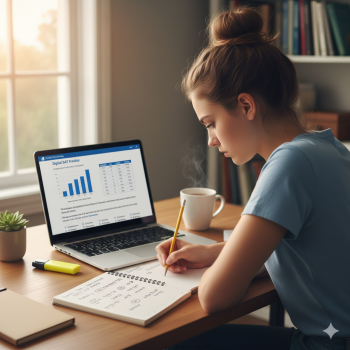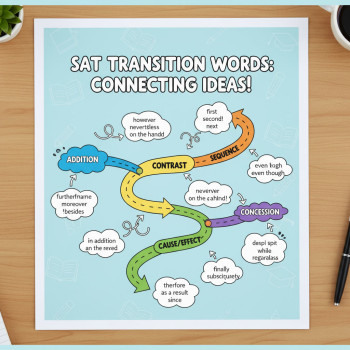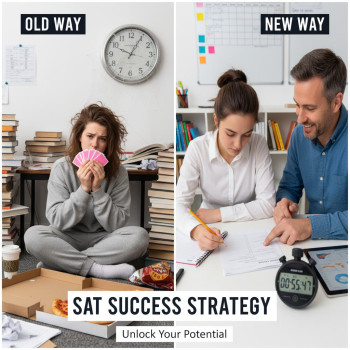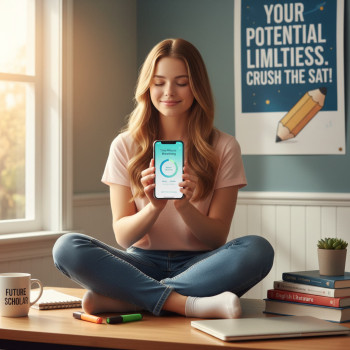Why multitasking across devices doesn’t have to mean losing control
It’s 2025 — you study on a school Chromebook in homeroom, redo practice problems on your phone between classes, take a full-length Bluebook practice on your laptop at home, and review flashcards on a tablet right before bed. If that sounds familiar, welcome to the reality of modern SAT prep.
Having multiple devices is a huge advantage: you can turn spare minutes into study moments, try different practice formats, and run full digital practice tests in the exact environment you’ll use on test day. But it also brings a common headache: scattered notes, inconsistent practice logs, and the sinking feeling that you’ve forgotten to review that one tricky grammar rule.
This guide is for students who want to keep the freedom of multi-device studying while staying organized, consistent, and calm. You’ll get practical routines, easy templates, and realistic workflows — plus a few smart tips for syncing across devices without letting tech get in the way of studying.
Start with a simple principle: single source of truth
When you’re juggling devices, pick one place that always has your up-to-date plan and progress. Think of it like your study command center. It could be a cloud-based note (Google Docs, Microsoft OneNote), a habit-tracking app, or a single folder in a note-taking app available on all your devices. The key is that every other tool only feeds into that center — you don’t have multiple “authoritative” lists.
Why this matters:
- Less duplication: you won’t waste time redoing tasks you already finished.
- Fewer contradictions: when your schedule or goal changes, update it once and it’s everywhere.
- Better reflection: a consolidated log helps you spot trends (e.g., you consistently miss timing on Math).
How to pick your study command center
- If you prefer structure: use a cloud document (Google Docs or OneDrive). Create a single sheet with sections for schedule, metrics, and notes.
- If you like visual trackers: a Kanban board (like Trello-style boards) works well for moving tasks from “To Do” to “Done”.
- If you need quick access on mobile: a synced notes app with sections (Notion, OneNote, or your phone’s notes app) will save you time.
Build a device-aware study workflow
A workflow ties your devices to specific tasks so each device becomes a reliable extension of your study routine, not a source of confusion.
An example workflow — device by device
- Phone: quick daily flashcard review, micro-practice (5–10 minute grammar bursts), and timers for short focus sessions.
- Tablet: active reading practice, annotated passages, and audio review of vocab (great for evenings or commuting).
- Laptop: full practice tests in Bluebook, longer timed sections, deep review with detailed error logs and spreadsheets.
- School Chromebook: in-class review with teacher prompts, scheduled Bluebook check-ins, and group study sessions.
Daily schedule template (one-week snapshot)
| Time | Device | Task | Goal |
|---|---|---|---|
| 7–7:20 AM | Phone | Vocabulary flashcards | 10 new words + 20 review |
| Lunch break | Chromebook (school) | Short grammar practice (1 passage) | Accuracy > 80% |
| After school | Tablet | Read & annotate a 700-word passage | Identify main idea & structure |
| Evening | Laptop | 1 math section (timed) + error log | Improve by 1–2 accuracy points |
| Weekend | Laptop | Full Bluebook practice test | Simulate test-day conditions |
This template is flexible: swap devices for tasks that fit your habits. The point is clarity — when you open a device, you know the task you’ll work on.
Use tools that sync automatically
Automatic sync is the difference between “I’ll update this later” and “my study log is current.” Choose apps and services that keep everything synced in real time so you’re not worried about which device has the latest version.
Recommended features to look for
- Cloud autosave (no manual upload step)
- Cross-platform apps (iOS, Android, Windows, macOS, and web)
- Offline access with automatic resync when online
- Easy export options (CSV or PDF) for sharing progress with a tutor or parent
Make practice logs your best friend
Logs are simple but powerful. Track what you did, how long you spent, your score, and one quick note about the main mistake. Over weeks, this gives you patterns to target.
Minimal practice log format
- Date
- Device used
- Activity (e.g., Bluebook math section, 20 vocab cards)
- Time spent
- Score/result
- One-line takeaway (e.g., “timing on last 5 questions”)
Store this log in your study command center. If you like spreadsheets, use columns; if you prefer notes, create a short bullet per session. The key is consistency.
Plan full-length practice tests like a pro
Full tests are the backbone of a smart SAT plan — they reveal stamina, pacing, and where your scores actually are. But setting up a full practice test across devices needs an intentional approach so you can mimic test-day conditions.
Checklist for a digital full-length practice test
- Use Bluebook on the device you’ll test on whenever possible.
- Charge your device fully and have a charger on hand.
- Clear notifications and close background apps that might distract (or use Do Not Disturb).
- Set up a quiet, uninterrupted space and use the same time limits as test day.
- Record start and end times in your log and note breaks exactly as on test day.
Keep notes and error logs central and searchable
After each practice section, write a short error log: what went wrong, why it happened, and how you’ll fix it next time. Tag entries by skill (e.g., “algebra”, “passage inference”, “comma rules”). This lets you filter trends when you have limited study time.
Example error-log entries
- “Algebra: misread variable relationship in Q12 — underline relationships before solving.”
- “Reading: missed purpose question — read introduction and conclusion sentences first on similar passages.”
- “Writing: wrong comma insertion — review comma rules for dependent clauses.”
Leverage micro-sessions to fill gaps
Short, intense sessions (5–15 minutes) are perfect for phones and tablets. Use those moments for:
- Flashcards and vocabulary
- Single-passage reading with a timing constraint
- Targeted math drill sets (5–8 problems)
- Short grammar or punctuation quizzes
These micro-sessions are less about building endurance and more about sharpening specific skills identified in your error log.
Make test-day tech rehearsals non-negotiable
At least once before your official test, simulate the entire test-day process on the device you’ll use. Download Bluebook, complete exam setup, run through a practice test, and walk through logistics like charging, arrival time, and identification. If you need a loaned device from your school or from College Board, practice on a similar machine so nothing on test day feels foreign.
Share progress (selectively) for accountability
Having someone — a parent, a study buddy, or a tutor — glance at your practice logs once a week adds gentle accountability. Sharing also helps a tutor tailor sessions to your needs: they can see which question types cause trouble and what to focus on next.
If you work with a personalized service like Sparkl’s personalized tutoring, sharing your synced log and error trends helps your tutor create targeted 1-on-1 guidance and a tailored study plan, speeding up improvement.
Smart backup habits to avoid data loss
Nothing derails momentum like losing a month of notes. A few simple precautions keep your command center safe across devices:
- Enable automatic cloud backups for your primary app.
- Export a weekly snapshot of your practice log (PDF or CSV) and save one copy on a separate cloud account or external drive.
- Take screenshots of important charts or logs as a last resort — these are easy to view on any device.
When devices disagree: compatibility and the Bluebook app
The digital SAT runs in the Bluebook testing app on supported laptops, tablets, iPads, and school-managed Chromebooks. Make sure the device you plan to use is on the list of approved devices and that you install Bluebook early so you can complete exam setup at least five days before the test.
If you rely on multiple devices for practice, remember that some practice features behave differently across platforms (for example, offline downloads, screen sizes, and keyboard types). Treat your laptop practice sessions as the closest simulation of test day if that is the device you’ll use for the exam.
Practical file and note organization tips
When you study across devices, the way you name files matters. Good conventions save time and mental energy.
- Use a consistent file name format: YYYY-MM-DD_section_topic (e.g., 2025-09-15_Math_Functions_errors).
- Create folders by month and then by skill area.
- Pin a short “Today” note in your command center with two priorities: a skill focus and a timed practice target.
Use analytics — but don’t get stuck in the numbers
Track three meaningful metrics: accuracy, pacing (time per question), and frequency (how often you practice each skill). Weekly trends tell you whether focused practice is working. If accuracy improves but pacing lags, switch to timed drills that emphasize speed. If frequency falls, shorten sessions and prioritize consistency.
When to get 1-on-1 help
If you’ve logged several weeks of practice and still see the same mistakes, it’s time for personalized intervention. A tutor can diagnose root causes quickly — is it a reading-strategy gap, shaky algebra fundamentals, or test anxiety? Personalized tutoring, like what Sparkl offers, blends tailored study plans, expert tutors, and AI-driven insights to turn your practice log into actionable next steps. That kind of guidance is especially useful when your device workflow is solid but your progress has plateaued.
Sample 8-week plan for multi-device prep
| Week | Focus | Devices | Weekly Goal |
|---|---|---|---|
| 1–2 | Baseline & pacing | Laptop (Bluebook), phone | Complete diagnostic, establish error log |
| 3–4 | Skill blocks (Math & Reading fundamentals) | Tablet, laptop, phone | Raise section accuracy by 3–5 points |
| 5–6 | Timing & strategy | Laptop (timed sections), phone (micro-drills) | Improve pacing and reduce last-question errors |
| 7 | Full-length practices | Laptop (Bluebook) | 2 full practice tests under test-day conditions |
| 8 | Polish & logistics | Chromebook/laptop | Final device check, review key rules, rest |
Small habits that make multi-device study sustainable
- End each study session with one sentence in your command center summarizing what you learned.
- Every Sunday, review the log and set three priorities for the week.
- Schedule one device rehearsal for test-day steps (install, exam setup) at least two weeks before your test.
Image ideas
Final checklist before the big day
- Confirm which device you’ll use and install Bluebook well in advance.
- Run one full-device rehearsal: download, complete exam setup, and simulate the test.
- Export or snapshot your practice log and bring a printed plan for the test day (timing, breaks, and arrival time).
- Charge devices, pack chargers, and bring an external keyboard if required for tablets.
- If you use a loaned device, arrive early to complete sign-in and setup as instructed by your test center.
Parting thoughts: tech is a tool, not the test
Multiple devices give you flexibility and power — but only if you tame the chaos. By centralizing your plan, assigning devices clear roles, logging practice consistently, and rehearsing on your testing device, you turn scattered study time into coherent progress. Keep it simple, make small, trackable goals, and build routines that match your life.
If you ever feel stuck, remember that targeted help can shorten your path to improvement. A few sessions of tailored 1-on-1 guidance (especially when paired with an accurate practice log and AI-driven insights) can turn a plateau into momentum — and that’s exactly the kind of boost many students find with personalized tutoring options.
Above all: study in ways that keep you curious, calm, and confident. Your devices should help you practice smarter — not just harder. Now plug in, sync up, and let every device move you one step closer to the score you want.

















No Comments
Leave a comment Cancel